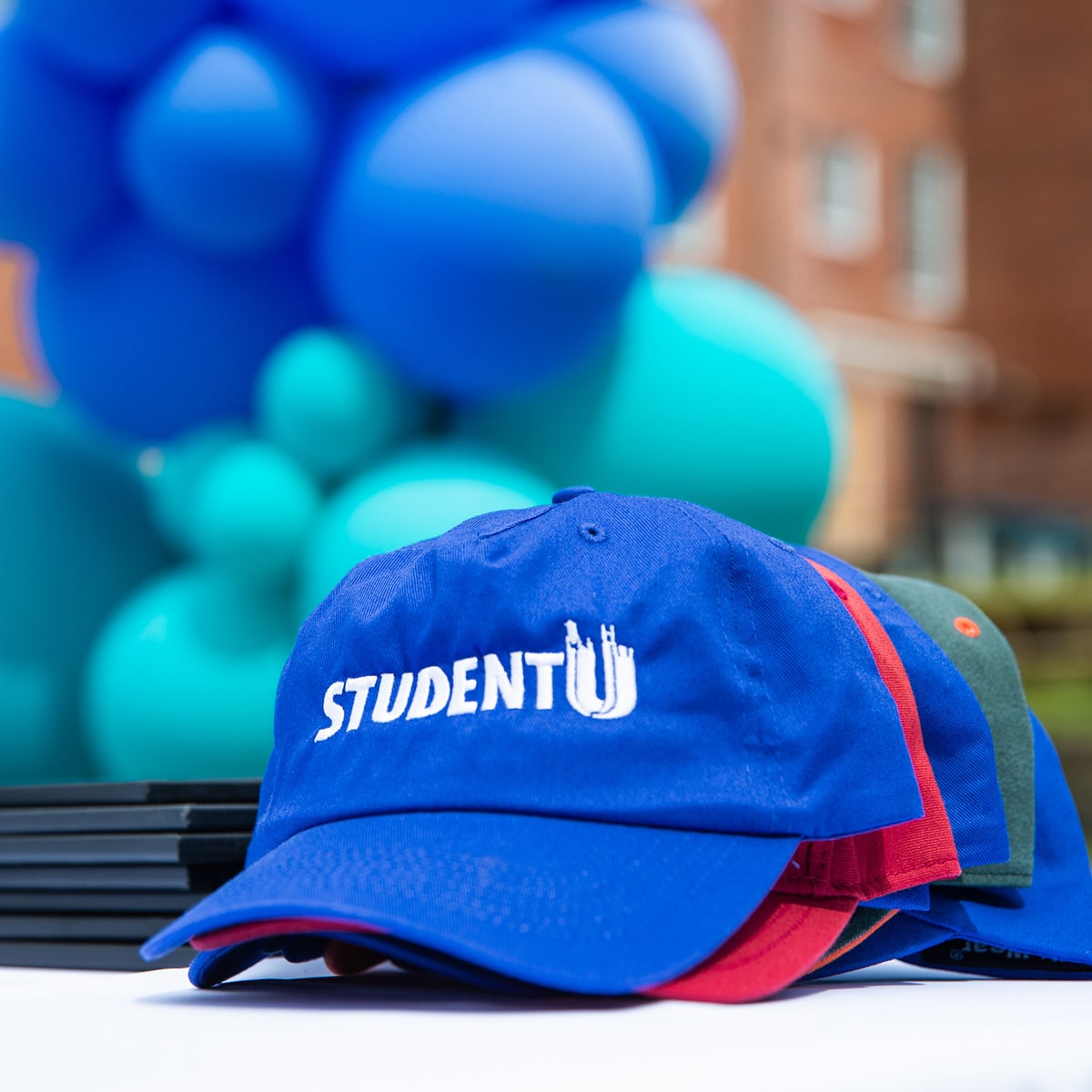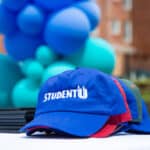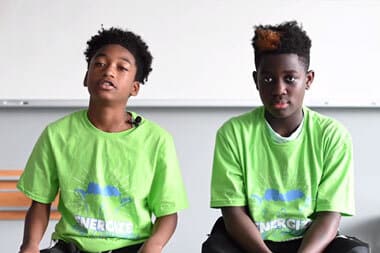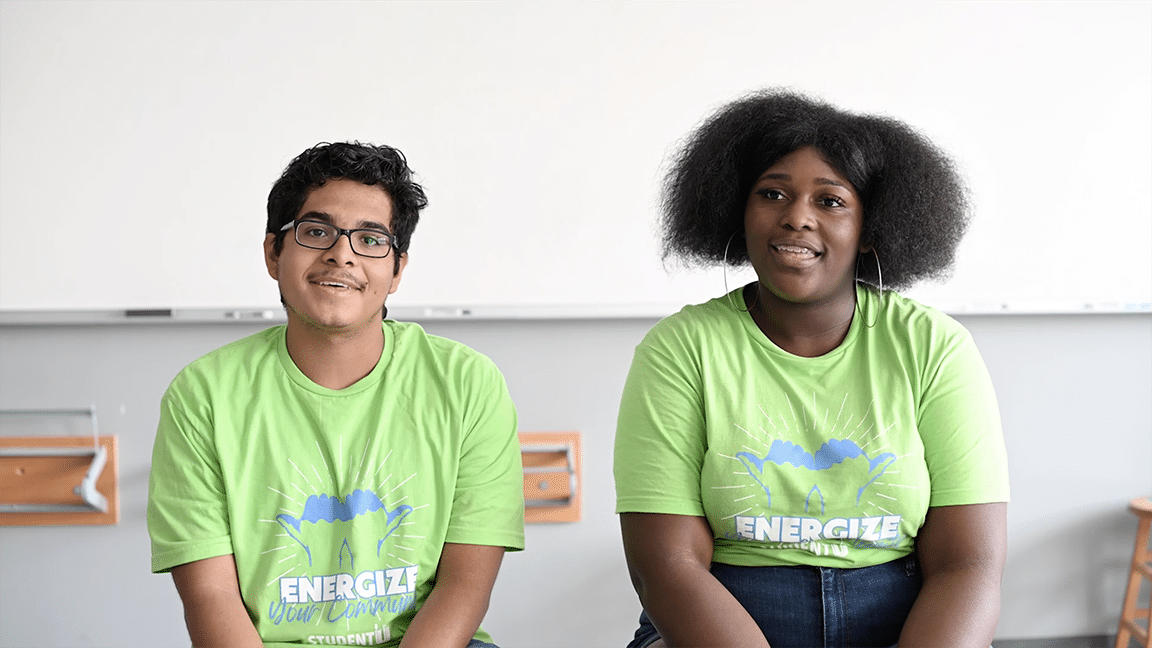A Vision for Durham
Meet Student U’s Executive Director
Duke Chronicle, By Laurel Burk | March 26, 2013
Dan Kimberg draws me a picture. It’s a three-ringed bull’s eye. He scrawls “what” inside the outer ring; the next one he labels “how”; occupying the coveted center is “why.” We are sitting in the commons of the Sanford School of Public Policy, but the conversation tends more toward philosophy and ethics. Before sitting down with me, Dan, Trinity ’07, was whipping off a flurry of emails on his laptop—the nonstop life of a nonprofit director. Leaning forward on the edge of a padded bench, my boss and friend gestures at his sketch with a pen.
“A lot of times in life we focus on the ‘what,’” he says. “What does Student U do? We provide a six-week summer program and ongoing support throughout the school year. We provide students with skills.”
I’m not surprised that he’s mocked up a visual aid—in his role as co-founder and executive director of the educational organization Student U—which provides academic opportunities to low-income area students, largely through summer programming—Kimberg is all about vision. He has given presentations to six groups of summer staff since his program’s inception, yet always seems to have a new guiding metaphor for the role of a Student U teacher or the function of a learning community. A wizard with Prezi, he’s a master of distilling expansive concepts into their component parts, then zooming back out again to show how they are integral to the whole—a quality of a good teacher.
In presentations to donors, faculty and even students, he harnesses big ideas to demonstrate the scope and gravity of the task of battling educational inequality. His speaking style can best be described as “feverish,” exuding passion and urgency, while making it clear what the audience can do to further the cause. “Compliment and challenge” is his self-professed motivational strategy. It’s the best formula for convincing prospective teachers, families and contributors that the “U” in Student U stands for you.
Kimberg moves on to the second ring of his bull’s eye to address the “how” of his brainchild: through a two-way “pipeline” that runs from the university students in the Triangle to Durham Public Schools students, and back. Under the guidance of DPS and Teach for America mentors, college students assume titles like Mr. Matt and Ms. Lauren, and are entrusted with their own summer classrooms; the students come from middle schools all across Durham. In keeping with this “how,” the nonprofit’s tagline is “where students are teachers, and teachers are students.”
We’ve arrived at the bull’s eye’s inner circle. He laments that the underlying “why” of businesses and organizations is often neglected: “If we’re great at what we do, we should start with the why.”
Dan has finished with the drawing and reestablishes his characteristic intense eye contact. He takes a meaningful pause before delving into an explanation of his organization’s core mission. The simplest “why” for Student U is that Durham asked for it. Seven years ago, enrolled as a long-haired, bearded undergraduate in a Duke Social Entrepreneurship course, Kimberg and the two other co-founders of Student U—Amanda Dorsey (now Amanda Kimberg), Trinity ’08, and Mary Williams, a Chapel Hill Robertson Scholar who also graduated in 2008—asked Durham what it needed from them. The answer, gleaned from local community members, was an academic bridge from elementary to high school for some of the area’s most underserved students. There was an abundance of enrichment programs for the youngest and oldest students in the DPS system, as well as a prevailing sense that middle school is a crucial turning point in young lives. Thus, Student U was born to serve Durham middle school students at risk of disconnecting with the school system. The uncommon efforts of its students, faculty and administrators have not gone unnoticed—the Durham Chamber of Commerce named the organization its Nonprofit of the Year in 2010.
There’s another “why” at work here, though—why Kimberg? The son of social workers and grandson of Holocaust survivors, Kimberg attributes his orientation toward service and his belief in education to the influence of his family. He recalls when his maternal grandmother—who met her husband fleeing Nazi occupation—was once disappointed in him for scoring in the 98th percentile on a New York state Regents examination in Language Arts. Even as an immigrant with limited English proficiency, she had managed to earn the best score in her school on her own Regents exam. She put in the hard work, he says, “because she knew education was the pathway to success in America.” For him, the story illustrates the power of a commitment to learning—a value that he’s carried with him on his own journey.
He admits to losing sight of this commitment at one point along the way. After arriving at Duke in 2003 as a Robertson scholar, Kimberg seemed to shrink rather than thrive in a competitive higher education environment, despite his upbringing.
“My first year at Duke,” he explains, “I tried my best to be average in every way.” Feeling like his light was being snuffed out by Duke’s academic and social culture—and expected by his scholarship program to do something useful with his summer—Kimberg applied to teach with Breakthrough Collaborative, a national organization that offers academic enrichment programs for high-potential, underserved middle schoolers, after his freshman year. Motivated, he says, by little more than a desire to spend the summer in New Orleans, Kimberg accepted an offer to teach English for underserved fifth-grade students. What started as an obligation and opportunity for summer travel became a transformative experience, reigniting Kimberg’s passion for service and re-solidifying for him the importance of education—and education equality. He was struck by the “brilliance” (a hallmark of Kimberg’s vocabulary) of each of his students, and had the opportunity to share his “best, fullest self,” the one he’d been hiding from the Duke community.
Arriving back on campus emboldened by a renewed sense of purpose, Kimberg drew on this set of experiences to respond to Durham’s specific needs. Through a “two-year listening tour of Durham,” which Kimberg spent in schools and meetings with community members, his social entrepreneurship project began to take real-world shape. With the other co-founders, he worked to develop Student U’s six-week academic enrichment program, which welcomed its first class of students in the summer of 2007. Core academic courses in English, science, math and “global connect” combated the notorious phenomenon of “summer loss,” in which low-income students lose up to 25 percent of what they have learned during the school year. Much of the racial and socioeconomic achievement gap in formal education can be explained in terms of this pattern, and it can spell disaster for students already behind grade-level. Student U has since grown to serve 285 students and has added a burgeoning high school Summer Academy. The organization’s first cohort won’t graduate from high school until 2014, but so far the results are promising—on average, Student U students outperform matched pairs in the DPS system on measures of classroom grades and End-of-Grade exam passage rates.
Raising test scores is all well and good, but none of this gets to the core of Kimberg’s organizational “why.” Why does Durham need Student U in the first place? Why are national debates raging about education reform? The blond, bright-eyed founder—now more well-groomed than his former undergraduate self—approaches the question from a perspective of social justice, framing it in terms of pure unfairness.
“We are living in a community where the trajectory for an individual, of an individual’s life, is so much based on that person’s race and where that person’s being born in Durham,” he says. “We have schools that are 98 percent black and Latino. We have schools where 95 percent of kids qualify for free and reduced[-priced] lunch.”
This separate and unequal state of affairs—which Kimberg calls “absurd”—is an obvious consequence of a nationwide neighborhood school system heavily funded by local property taxes. Affluent areas levy higher taxes, leading to richer districts that can use their differential resources to attract and retain better teachers, while maintaining more appealing school facilities. Those affluent areas, Kimberg notes, also tend to be white areas.
“Racism is around us every single day,” he says. “We are in a racist society still, for sure.”
Is it the racism of the 1950s? No, but it is racism nonetheless. Kimberg calls up segregation imagery to discuss the demographics of schools in Durham and the U.S. in general. White kids and black kids, rich kids and poor kids going to different schools is not fundamentally different than having a black and a white water fountain, he says, especially when “teachers are different, access to supplies is different, the life path is different depending on which schools you go to.” Kimberg knows his statistics cold and uses them to paint a grim picture. Only 77 percent of the (mostly black) students in DPS are graduating from high school. The figure for low-income students drops to 72 percent. Nationwide, the picture gets bleaker: Only 52 percent of U.S. students from low-income backgrounds go to college, and of those, a meager 11 percent manage to graduate within six years. He repeats the last figure for emphasis—11 percent—calling it “unbelievable.”
But this isn’t just some numbers game. It’s Kimberg’s life’s work, and his students’ futures hang in the balance. He links educational achievement with not only economic solvency and intellectual growth, but even with basic survival. “Life expectancy—the number one indicator of life expectancy [in the U. S.]—is high school graduation,” he explains. “If our kids want to live, if they want to live a fulfilled, long life they need to graduate from high school.”
He may place a premium on education, but Kimberg isn’t so naïve as to have a one-step solution to all of Durham’s, and America’s, social ills. He cautions against regarding education as a “silver bullet” or a “magic wand that’s going to change the world.” Like many leaders in urban education—notably Geoffrey Canada of the Harlem Children’s Zone—Kimberg stresses the importance of wrap-around services. He identifies three tenets for social reform: education, housing and healthcare. The ideal Student U of the future would include expanded health and social work services, and the program is in the process of launching a comprehensive health and wellness program.
Could Student U ever be a school? Kimberg says sure, but it’s not a goal of his. Such a transformation would shrink the influence of Student U, he contends. Currently, students from throughout the district come to Student U for their summer studies and then return to their respective academic-year schools to impact their various classmates and teachers. Kimberg fears enclosing the community within four walls would confine its impact to the thousand or so students it could realistically serve, and stifle the ripple effect this kind of intervention is capable of having.
On the other hand, Kimberg also fears spreading the program too thin and fracturing a unified community. Despite having his first, fondly remembered teaching experience at Breakthrough Collaborative, he adamantly refuses to emulate that organization’s model of expanding to sites in different cities and states. There have been offers and interest, but he says he will not even consider an additional location until all of Durham’s high-need students have the opportunity to chip away at the achievement gap each summer. Student U partners with Triangle universities and mines some of the area’s brightest college talent; students in the program eat hot, healthy meals from Durham Catering Company; Durham’s Local Yogurt brightens one staff meeting each summer with free frozen yogurt for the much-appreciated college-student teachers. In Kimberg’s words, Student U is a program “in Durham, for Durham, by Durham.”
For the foreseeable future, Student U will be a work in progress. The nonprofit will get its most substantial feedback—whether encouraging or sobering—as it tracks its first graduates through college in the coming years. Each morning of the six-week summer institute, 150 middle schoolers recite the Student U Affirmation, declaring they are “destined to change the world.” With Kimberg in their corner, they’ve got a fighting chance to do just that. Like its students and its founder, Student U is young, with an eye to the future and a willingness to change not only the world, but also itself.









